Fei Yang
Not All Parameters Matter: Masking Diffusion Models for Enhancing Generation Ability
May 06, 2025
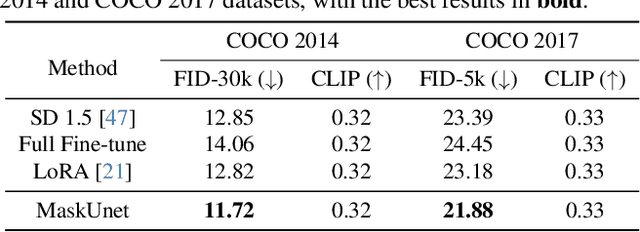
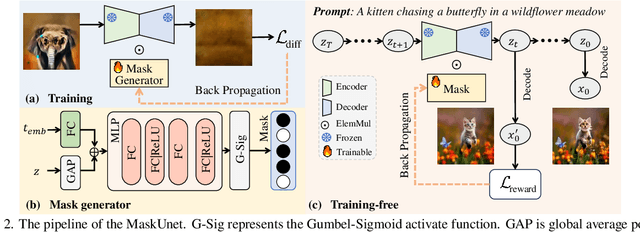
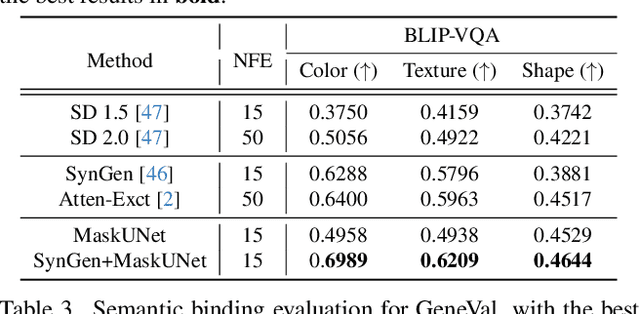
Abstract:The diffusion models, in early stages focus on constructing basic image structures, while the refined details, including local features and textures, are generated in later stages. Thus the same network layers are forced to learn both structural and textural information simultaneously, significantly differing from the traditional deep learning architectures (e.g., ResNet or GANs) which captures or generates the image semantic information at different layers. This difference inspires us to explore the time-wise diffusion models. We initially investigate the key contributions of the U-Net parameters to the denoising process and identify that properly zeroing out certain parameters (including large parameters) contributes to denoising, substantially improving the generation quality on the fly. Capitalizing on this discovery, we propose a simple yet effective method-termed ``MaskUNet''- that enhances generation quality with negligible parameter numbers. Our method fully leverages timestep- and sample-dependent effective U-Net parameters. To optimize MaskUNet, we offer two fine-tuning strategies: a training-based approach and a training-free approach, including tailored networks and optimization functions. In zero-shot inference on the COCO dataset, MaskUNet achieves the best FID score and further demonstrates its effectiveness in downstream task evaluations. Project page: https://gudaochangsheng.github.io/MaskUnet-Page/
KAC: Kolmogorov-Arnold Classifier for Continual Learning
Mar 27, 2025



Abstract:Continual learning requires models to train continuously across consecutive tasks without forgetting. Most existing methods utilize linear classifiers, which struggle to maintain a stable classification space while learning new tasks. Inspired by the success of Kolmogorov-Arnold Networks (KAN) in preserving learning stability during simple continual regression tasks, we set out to explore their potential in more complex continual learning scenarios. In this paper, we introduce the Kolmogorov-Arnold Classifier (KAC), a novel classifier developed for continual learning based on the KAN structure. We delve into the impact of KAN's spline functions and introduce Radial Basis Functions (RBF) for improved compatibility with continual learning. We replace linear classifiers with KAC in several recent approaches and conduct experiments across various continual learning benchmarks, all of which demonstrate performance improvements, highlighting the effectiveness and robustness of KAC in continual learning. The code is available at https://github.com/Ethanhuhuhu/KAC.
Learning Part Knowledge to Facilitate Category Understanding for Fine-Grained Generalized Category Discovery
Mar 21, 2025Abstract:Generalized Category Discovery (GCD) aims to classify unlabeled data containing both seen and novel categories. Although existing methods perform well on generic datasets, they struggle in fine-grained scenarios. We attribute this difficulty to their reliance on contrastive learning over global image features to automatically capture discriminative cues, which fails to capture the subtle local differences essential for distinguishing fine-grained categories. Therefore, in this paper, we propose incorporating part knowledge to address fine-grained GCD, which introduces two key challenges: the absence of annotations for novel classes complicates the extraction of the part features, and global contrastive learning prioritizes holistic feature invariance, inadvertently suppressing discriminative local part patterns. To address these challenges, we propose PartGCD, including 1) Adaptive Part Decomposition, which automatically extracts class-specific semantic parts via Gaussian Mixture Models, and 2) Part Discrepancy Regularization, enforcing explicit separation between part features to amplify fine-grained local part distinctions. Experiments demonstrate state-of-the-art performance across multiple fine-grained benchmarks while maintaining competitiveness on generic datasets, validating the effectiveness and robustness of our approach.
Restoring Forgotten Knowledge in Non-Exemplar Class Incremental Learning through Test-Time Semantic Evolution
Mar 21, 2025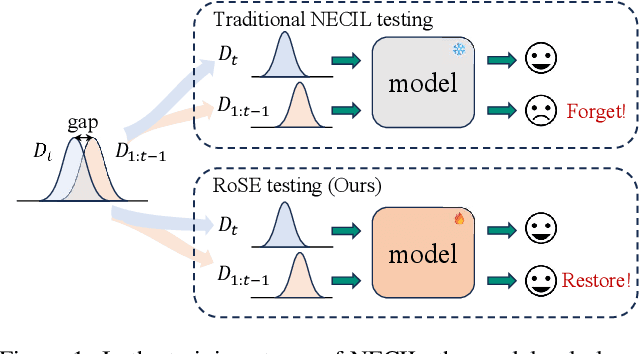
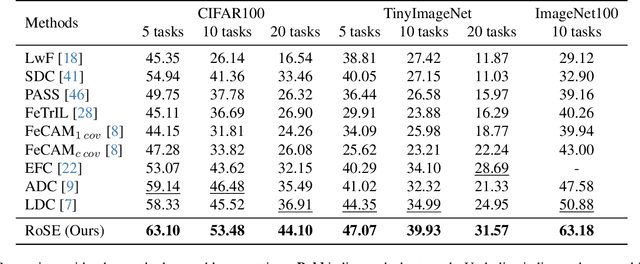
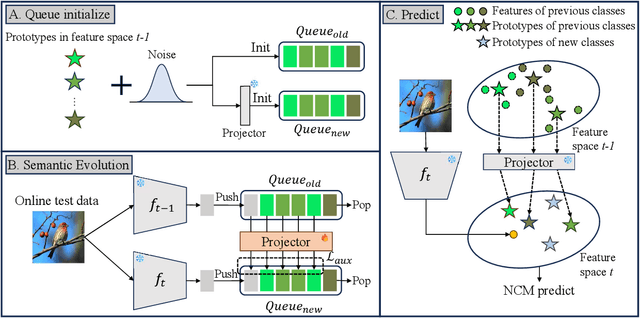
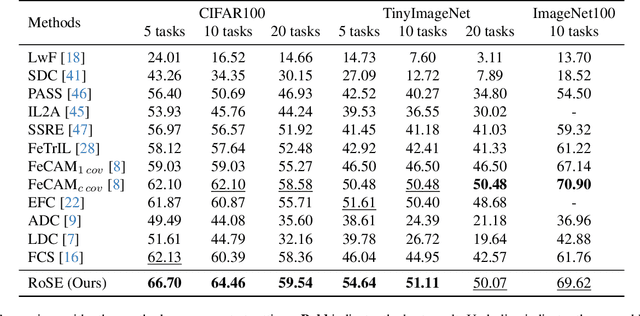
Abstract:Continual learning aims to accumulate knowledge over a data stream while mitigating catastrophic forgetting. In Non-exemplar Class Incremental Learning (NECIL), forgetting arises during incremental optimization because old classes are inaccessible, hindering the retention of prior knowledge. To solve this, previous methods struggle in achieving the stability-plasticity balance in the training stages. However, we note that the testing stage is rarely considered among them, but is promising to be a solution to forgetting. Therefore, we propose RoSE, which is a simple yet effective method that \textbf{R}est\textbf{o}res forgotten knowledge through test-time \textbf{S}emantic \textbf{E}volution. Specifically designed for minimizing forgetting, RoSE is a test-time semantic drift compensation framework that enables more accurate drift estimation in a self-supervised manner. Moreover, to avoid incomplete optimization during online testing, we derive an analytical solution as an alternative to gradient descent. We evaluate RoSE on CIFAR-100, TinyImageNet, and ImageNet100 datasets, under both cold-start and warm-start settings. Our method consistently outperforms most state-of-the-art (SOTA) methods across various scenarios, validating the potential and feasibility of test-time evolution in NECIL.
Improving Video Generation with Human Feedback
Jan 23, 2025



Abstract:Video generation has achieved significant advances through rectified flow techniques, but issues like unsmooth motion and misalignment between videos and prompts persist. In this work, we develop a systematic pipeline that harnesses human feedback to mitigate these problems and refine the video generation model. Specifically, we begin by constructing a large-scale human preference dataset focused on modern video generation models, incorporating pairwise annotations across multi-dimensions. We then introduce VideoReward, a multi-dimensional video reward model, and examine how annotations and various design choices impact its rewarding efficacy. From a unified reinforcement learning perspective aimed at maximizing reward with KL regularization, we introduce three alignment algorithms for flow-based models by extending those from diffusion models. These include two training-time strategies: direct preference optimization for flow (Flow-DPO) and reward weighted regression for flow (Flow-RWR), and an inference-time technique, Flow-NRG, which applies reward guidance directly to noisy videos. Experimental results indicate that VideoReward significantly outperforms existing reward models, and Flow-DPO demonstrates superior performance compared to both Flow-RWR and standard supervised fine-tuning methods. Additionally, Flow-NRG lets users assign custom weights to multiple objectives during inference, meeting personalized video quality needs. Project page: https://gongyeliu.github.io/videoalign.
Achieving Full-Bandwidth Sensing Performance with Partial Bandwidth Allocation for ISAC
Dec 28, 2024



Abstract:This letter studies an uplink integrated sensing and communication (ISAC) system using discrete Fourier transform spread orthogonal frequency division multiplexing (DFT-s-OFDM) transmission. We try to answer the following fundamental question: With only a fractional bandwidth allocated to the user with sensing task, can the same delay resolution and unambiguous range be achieved as if all bandwidth were allocated to it? We affirmatively answer the question by proposing a novel two-stage delay estimation (TSDE) method that exploits the following facts: without increasing the allocated bandwidth, higher delay resolution can be achieved via distributed subcarrier allocation compared to its collocated counterpart, while there is a trade-off between delay resolution and unambiguous range by varying the decimation factor of subcarriers. Therefore, the key idea of the proposed TSDE method is to first perform coarse delay estimation with collocated subcarriers to achieve a large unambiguous range, and then use distributed subcarriers with optimized decimation factor to enhance delay resolution while avoiding delay ambiguity. Our analysis shows that the proposed TSDE method can achieve the full-bandwidth delay resolution and unambiguous range, by using only at most half of the full bandwidth, provided that the channel delay spread is less than half of the unambiguous range. Numerical results show the superiority of the proposed method over the conventional method with collocated subcarriers.
VIVID-10M: A Dataset and Baseline for Versatile and Interactive Video Local Editing
Nov 22, 2024



Abstract:Diffusion-based image editing models have made remarkable progress in recent years. However, achieving high-quality video editing remains a significant challenge. One major hurdle is the absence of open-source, large-scale video editing datasets based on real-world data, as constructing such datasets is both time-consuming and costly. Moreover, video data requires a significantly larger number of tokens for representation, which substantially increases the training costs for video editing models. Lastly, current video editing models offer limited interactivity, often making it difficult for users to express their editing requirements effectively in a single attempt. To address these challenges, this paper introduces a dataset VIVID-10M and a baseline model VIVID. VIVID-10M is the first large-scale hybrid image-video local editing dataset aimed at reducing data construction and model training costs, which comprises 9.7M samples that encompass a wide range of video editing tasks. VIVID is a Versatile and Interactive VIdeo local eDiting model trained on VIVID-10M, which supports entity addition, modification, and deletion. At its core, a keyframe-guided interactive video editing mechanism is proposed, enabling users to iteratively edit keyframes and propagate it to other frames, thereby reducing latency in achieving desired outcomes. Extensive experimental evaluations show that our approach achieves state-of-the-art performance in video local editing, surpassing baseline methods in both automated metrics and user studies. The VIVID-10M dataset and the VIVID editing model will be available at \url{https://inkosizhong.github.io/VIVID/}.
Unified Pathological Speech Analysis with Prompt Tuning
Nov 05, 2024
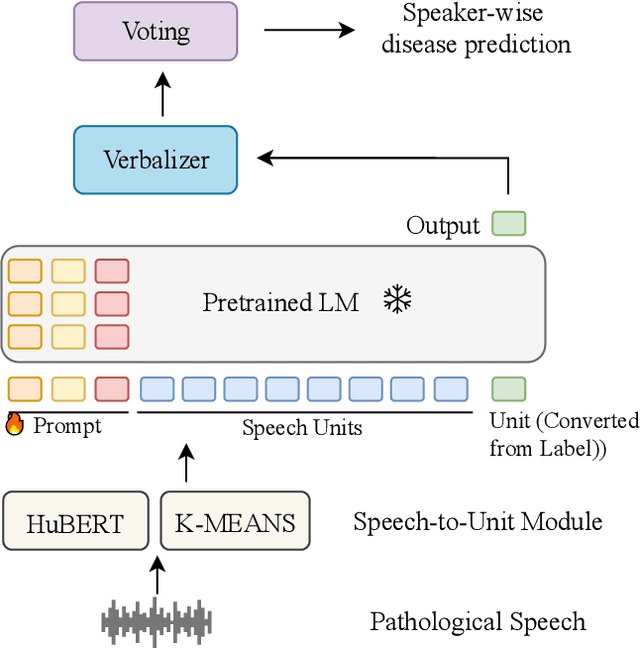
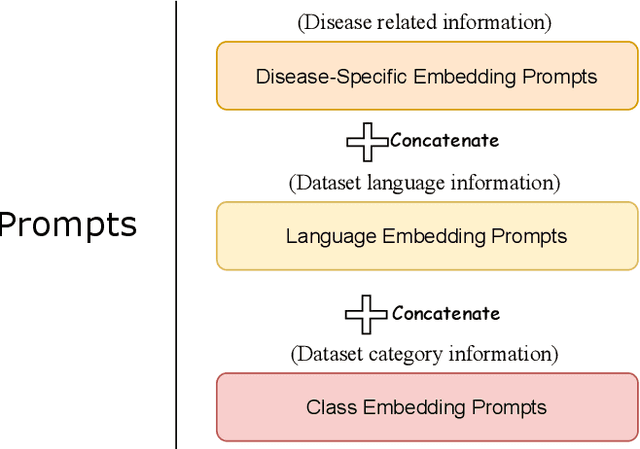
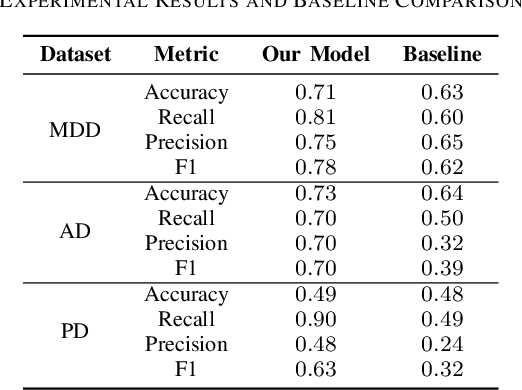
Abstract:Pathological speech analysis has been of interest in the detection of certain diseases like depression and Alzheimer's disease and attracts much interest from researchers. However, previous pathological speech analysis models are commonly designed for a specific disease while overlooking the connection between diseases, which may constrain performance and lower training efficiency. Instead of fine-tuning deep models for different tasks, prompt tuning is a much more efficient training paradigm. We thus propose a unified pathological speech analysis system for as many as three diseases with the prompt tuning technique. This system uses prompt tuning to adjust only a small part of the parameters to detect different diseases from speeches of possible patients. Our system leverages a pre-trained spoken language model and demonstrates strong performance across multiple disorders while only fine-tuning a fraction of the parameters. This efficient training approach leads to faster convergence and improved F1 scores by allowing knowledge to be shared across tasks. Our experiments on Alzheimer's disease, Depression, and Parkinson's disease show competitive results, highlighting the effectiveness of our method in pathological speech analysis.
Multi-Class Textual-Inversion Secretly Yields a Semantic-Agnostic Classifier
Oct 29, 2024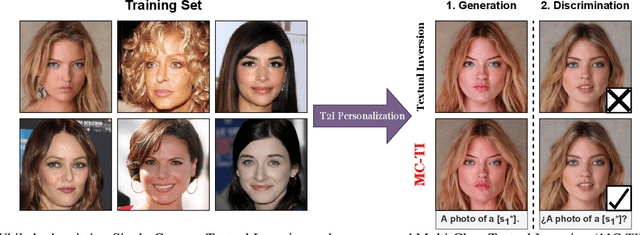
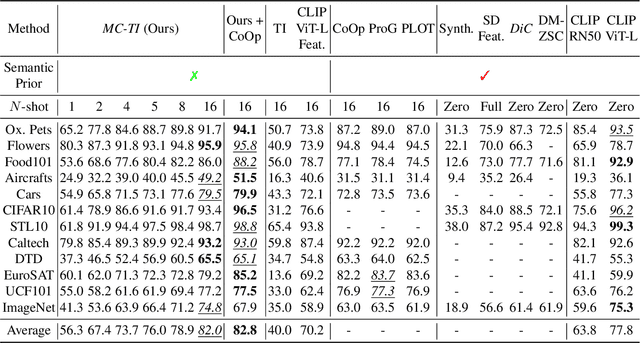
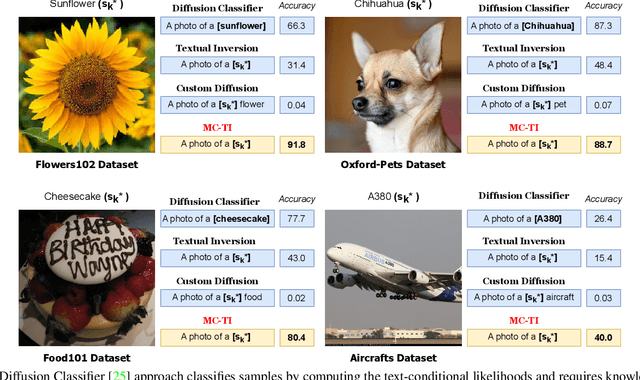

Abstract:With the advent of large pre-trained vision-language models such as CLIP, prompt learning methods aim to enhance the transferability of the CLIP model. They learn the prompt given few samples from the downstream task given the specific class names as prior knowledge, which we term as semantic-aware classification. However, in many realistic scenarios, we only have access to few samples and knowledge of the class names (e.g., when considering instances of classes). This challenging scenario represents the semantic-agnostic discriminative case. Text-to-Image (T2I) personalization methods aim to adapt T2I models to unseen concepts by learning new tokens and endowing these tokens with the capability of generating the learned concepts. These methods do not require knowledge of class names as a semantic-aware prior. Therefore, in this paper, we first explore Textual Inversion and reveal that the new concept tokens possess both generation and classification capabilities by regarding each category as a single concept. However, learning classifiers from single-concept textual inversion is limited since the learned tokens are suboptimal for the discriminative tasks. To mitigate this issue, we propose Multi-Class textual inversion, which includes a discriminative regularization term for the token updating process. Using this technique, our method MC-TI achieves stronger Semantic-Agnostic Classification while preserving the generation capability of these modifier tokens given only few samples per category. In the experiments, we extensively evaluate MC-TI on 12 datasets covering various scenarios, which demonstrates that MC-TI achieves superior results in terms of both classification and generation outcomes.
Parameter-Efficient Fine-Tuning in Large Models: A Survey of Methodologies
Oct 24, 2024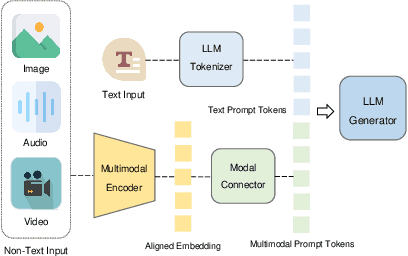
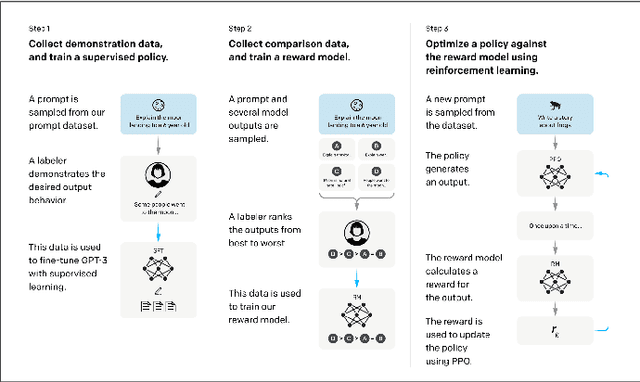

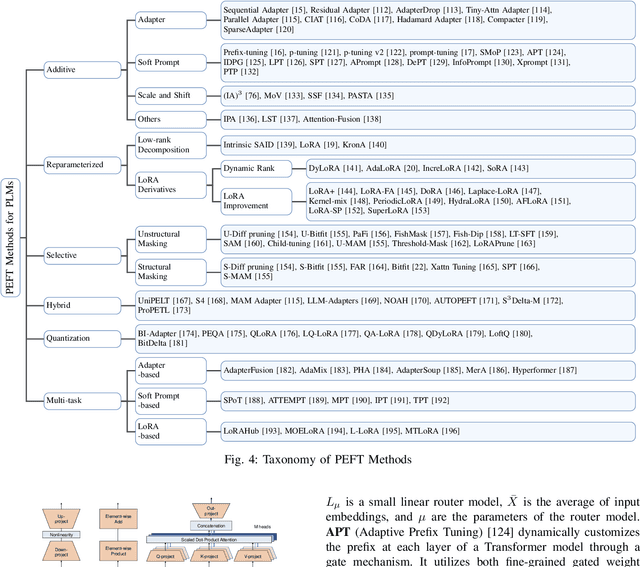
Abstract:The large models, as predicted by scaling raw forecasts, have made groundbreaking progress in many fields, particularly in natural language generation tasks, where they have approached or even surpassed human levels. However, the unprecedented scale of their parameters brings significant computational and storage costs. These large models require substantial computational resources and GPU memory to operate. When adapting large models to specific downstream tasks, their massive parameter scale poses a significant challenge in fine-tuning on hardware platforms with limited computational power and GPU memory. To address this issue, Parameter-Efficient Fine-Tuning (PEFT) offers a practical solution by efficiently adjusting the parameters of large pre-trained models to suit various downstream tasks. Specifically, PEFT adjusts the parameters of pre-trained large models to adapt to specific tasks or domains, minimizing the introduction of additional parameters and the computational resources required. This review mainly introduces the preliminary knowledge of PEFT, the core ideas and principles of various PEFT algorithms, the applications of PEFT, and potential future research directions. By reading this review, we believe that interested parties can quickly grasp the PEFT methodology, thereby accelerating its development and innovation.
 Add to Chrome
Add to Chrome Add to Firefox
Add to Firefox Add to Edge
Add to Edge